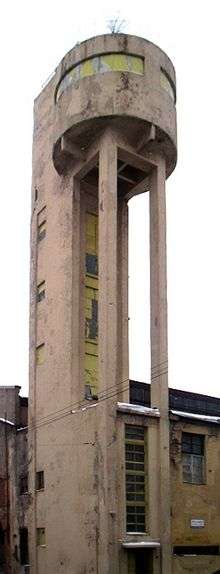Yakov Chernikhov

Yakov Georgievich Chernikhov (Яков Георгиевич Чернихов) (5 (17) December 1889 in Pavlograd, Yekaterinoslav Governorate, Russian Empire (now Pavlohrad, Ukraine) – 9 May 1951 in Moscow, Soviet Union) was a constructivist architect and graphic designer. His books on architectural design published in Leningrad between 1927 and 1933 are amongst the most innovatory texts (and illustrations) of their time.
Biography
Chernikov was born to a poor family, one of 11 children. After studying at the Grekov Odessa Art school, Ukraine he moved in 1914 to Petrograd (St. Petersburg) and joined the Architecture faculty of the Imperial Academy of Arts in 1916, where he later studied under Leon Benois. Greatly interested in futurist movements, including constructivism, and the suprematism of Malevich (with whom he was acquainted), he set out his ideas in a series of books in the late 1920s and early 1930s, including:
- The Art of Graphic Representation (1927)
- Fundamentals of Contemporary Architecture (1930)
- The Construction of Architectural and Machine Forms (1931)
- 101 Architectural Fantasies (1933)
The latter, a very fine example of colour printing, was perhaps the last avant-garde art book to be published in Russia during the Stalinist era. Its remarkable designs uncannily predict the architecture of the later 20th century. However his unusual ideas meant that Chernikhov was distrusted by the regime. Although he continued work as a teacher and held a number of one-man shows, few of his designs were built and very few appear to have survived. Amongst the latter is the tower of the 'Red Carnation' factory in St. Petersburg.
Chernikhov also produced a number of richly designed architectural fantasies of historic architecture, which were never exhibited in his lifetime. A book on 'The Construction of Letter Forms' containing some of his typographical designs, was published after his death, in 1959.
Chernikhov produced some 17,000 drawings and projects and was dubbed the Soviet Piranesi.[1] On 8 August 2006, it was announced that some hundreds of Chernikhov's drawings, with an estimated value of $1,300,000, had gone missing from the Russian State Archives. Some 274 have been recovered, in Russia and abroad.[2]
See also
References
- ↑ Mercatorfonds, Antwerp and Eaton, Ruth. 2001. Ideal Cities: Utopianism and the (Un)Built Environment, pp.193-194. ISBN 90-6153-475-5.
- ↑ BBC News. 8 August 2006. Valuable Russian drawings stolen. Accessed at http://news.bbc.co.uk/2/hi/europe/5255860.stm on 10 September 2009.
Sources
- Russian Constructivism and Iakov Chernikhov. Architectural Design magazine vol. 59 no. 7-8, London, 1989
- Documenti e Riproduzioni dall'Archivio di Aleksej e Dimitri Cernihov (Illustrated) ed. Carlo Olmo and Alessandro de Magistris, publisher Umberto Allemandi, 1995, ISBN 88-422-0474-9, in Italian
- Graphic Masterpieces of Yakov Georgievich Chernikhov: The Collection of Dmitry Chernikhov by Dmitry Y. Chernikhov DOM Publishers 2008 in English
- Chernikov Fantasy and Construction: Iakov Chernikov's Approach to Architectural Design (Architectural Design Profile) by Catherine Cooke, Iakov Chernikhov. St Martins Press, London 1985
External links
|